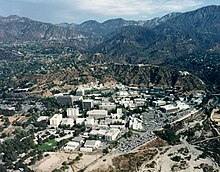JPL Science Division
 |
|
 |
|
 Aerial view of the Jet Propulsion Laboratory in La Cañada Flintridge, California |
|
| Agency overview | |
|---|---|
| Formed | 1936 |
| Type | Terrestrial and extraterrestrial sciences |
| Jurisdiction | United States |
| Headquarters |
Pasadena, California 34°12′04″N 118°10′21″W / 34.201060°N 118.172453°WCoordinates: 34°12′04″N 118°10′21″W / 34.201060°N 118.172453°W |
| Agency executives |
|
| Parent department | Jet Propulsion Laboratory |
| Parent agency | NASA |
| Website |
science science |
The Jet Propulsion Laboratory (JPL) Science Division investigates physical and chemical processes on the Earth, in the Solar System, and throughout the universe. Explorations of space and terrestrial processes lead to understanding of the universe. Methods for accomplishing scientific work pertaining to the nature of the Earth, the Solar System, the galaxy, etc., are addressed in the JPL Science Division. Techniques in both physical and life sciences are utilized.
Research areas include studying the nature of the Martian surface, the causes and mitigation of ozone depletion and global warming in Earth's atmosphere, the search for life in and the nature and evolution of the universe. These are significant issues related to NASA's mission.
Theoretical and experimental studies are conducted which lead to new missions. They are engaged in the development of new instrumentation and in the analysis of data, publishing new scientific knowledge, and in the communication of that knowledge to the general public.
Not all science at the Jet Propulsion Laboratory is contained within the Science Division. Approximately 30% of JPL scientists are embedded in other divisions.
JPL's charter is to conduct robotic space missions for NASA, to explore planetary systems, understand the origin and evolution of the universe and make critical measurements to understand the Earth, which leads to its protection. This is accomplished by developing multidisciplinary capabilities in engineering, science and technology. Research in space science, as well as advancing technologies, produces the ability to implement missions for NASA.
...
Wikipedia
